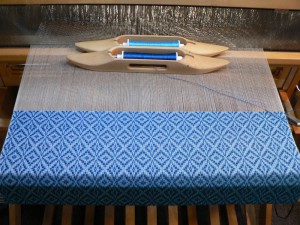Matthew pointed out that I have been spelling Hop Vine two ways: Hopvine as one word, and Hop Vine as two words. This is because I have seen it written both ways, and personally I don’t have a strong preference. Perhaps I should be more consistent, but I don’t have good criteria for choosing between the two spellings. Without good criteria, some decisions just can’t be made. INTP anyone?
Meanwhile, here are three more pieces that I’ve woven on this warp. I re-wrote the treadling to maintain a consistent tabby order, so the pattern looks a little different from my earlier woad- and madder-dyed pieces. All the yarns in this group are commercially dyed.
The one below has 10/2 tencel in Moroccan Blue for the pattern weft and 20/2 UKI cotton in Deep Turk for tabby:
You can see the actual color of the 20/2 yarn on the bobbin closest to the reed. You might be asking, “What happened to that bright blue?” The background of the cloth looks very light because the warp is off-white. It mutes the tabby color. As I recall from a class on color theory for weavers with Susan Loring Wells, a color plus white is called a tint. Continue reading “More Hop Vine and A Color Theory Question”

